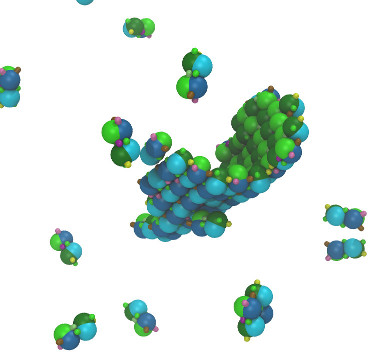Hi all,
In my simulation, I try to create a fake molecule of 10 atoms connected together to form a rod-shaped particle. All are fine initially, but after 7h of stimulation, I guess probably the environment is too dense, there is one broken molecule. I want to know is there any reason that can force the molecule to break? the density is increasing along with time, and I did try to avoid overlapping. And besides, the time it was broken, it shifts a large distance and those atoms are behaving weirdly, moving around in a way that I don’t really understand, and become normal after a while and linked together again as a molecule. The simulation stops later on due to losing 2 atoms. ( I hope these descriptions can help to identify my problem.)
Looking forward to some help!
Hi all,
In my simulation, I try to create a fake molecule of 10 atoms connected
together to form a rod-shaped particle. All are fine initially, but after
7h of stimulation, I guess probably the environment is too dense, there is
one broken molecule. *I want to know is there any reason that can force
the molecule to break? * the density is increasing along with time, and I
did try to avoid overlapping. And besides, the time it was broken, it
shifts a large distance and those atoms are behaving weirdly, moving around
in a way that I don't really understand, and become normal after a while
and linked together again as a molecule. The simulation stops later on due
to losing 2 atoms. ( I hope these descriptions can help to identify my
problem.)
how do you determine, that your molecule is "broken"?
with regular force fields, bond *cannot* be broken unless you explicitly
break them (which can be automated in LAMMPS).
what you describe sounds a lot like the symptoms of a bad force field or a
badly chosen (i.e. too large) time step. that is, atoms get too close, then
experience a huge repulsive force that kicks them around (= potential
energy is converted into kinetic energy) and then that excess local kinetic
energy is being dissipated.
lost atoms can happen for the same reasons, when those two atoms move too
fast after getting too close.
axel.
Hello Nie
Regarding the issue of broken molecules, you can try using “fix rigid” to preserve the shape of these fake molecules during the simulation. The only drawback is that you might have to use a smaller time-step in your simulation to avoid numerical instability.
This might not fix the problem you are having with lost atoms, but it is worth trying. (Later, if you figure out how to optimize the bond-lengths and bond-angles in order keep your fake molecule in a rigid conformation, then you can stop using “fix rigid”, and go back to using a larger timestep, if you like.)
For more details, see:
http://lammps.sandia.gov/doc/fix_rigid.html
I use it this way in my simulations:

